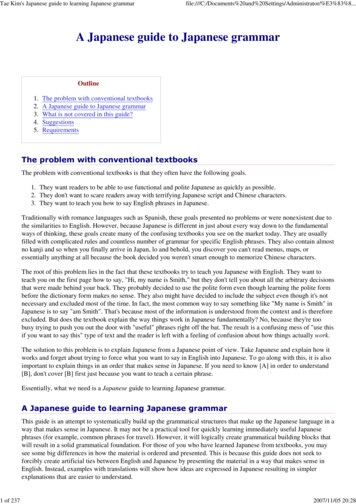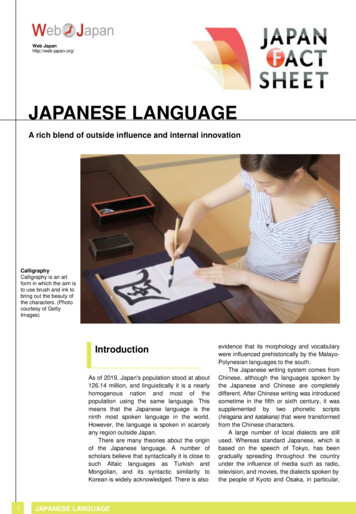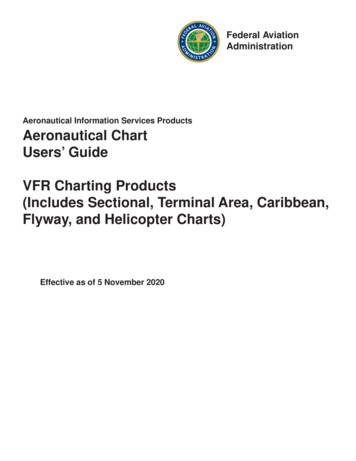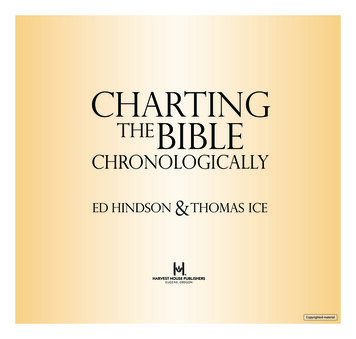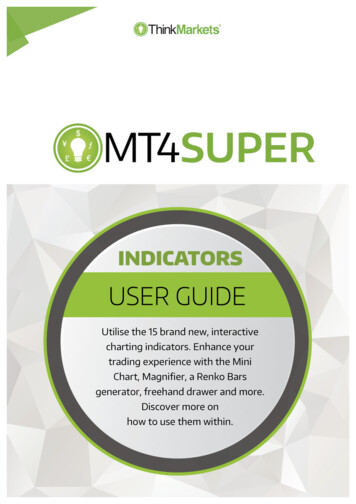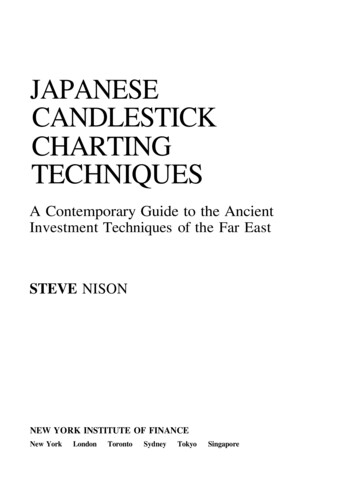
Transcription
JAPANESECANDLESTICKCHARTINGTECHNIQUESA Contemporary Guide to the AncientInvestment Techniques of the Far EastSTEVE NISONNEW YORK INSTITUTE OF FINANCENew YorkLondonTorontoSydneyTokyoSingapore
JAPANESE CANDLESTICKCHARTING TECHNIQUES
u-v 7 ("Candles Exhaust Themselves to Give Light to Men"
Library of Congress Cataloging-in-Publication DataNison, Steve.Japanese candlestick charting techniques : a contemporary guide tothe ancient investment technique of the Far East / Steve Nison.p. cm.Includes bibliographical references and index.ISBN 0-13-931650-71. Stocks—Charts, diagrams, etc. 2. Investment analysis.I. Title.HG4638.N57 199190-22736332.63'22—dc20CIPThis publication is designed to provide accurate and authoritative information in regard to the subject matter covered. It is sold with theunderstanding that the publisher is not engaged in rendering legal,accounting, or other professional service. If legal advice or other expertassistance is required, the services of a competent professionalperson should be sought.From a Declaration of Principles Jointly Adopted bya Committee of the American Bar Associationand a Committee of Publishers and Associations 1991 by Steve NisonAll rights reserved. No part of this book may be reproduced in anyform or by any means without permission in writing from the publisher.New York Institute of FinanceSimon & SchusterA Paramount Communications CompanyPrinted in the United States of America10 9 8 7 6 5 4 3 2IV
AcknowledgementsLike having ice cream after a tonsillectomy, this section is my treat afterthe book's completion.Some of those who deserve recognition for their help are addressedin Chapter 1 in my discussion of my candlestick education. There aremany others whom I would like to thank for their help along my candlestick path. Candles might help light the way, but without the assistanceand insights of many others it would have been almost impossible to dothis book. There were so many who contributed in one way or anotherto this project that if I have forgotten to mention anyone I apologize forthis oversight.The Market Technicians Association (MTA) deserves special mention.It was at the MTA's library that I first discovered candlestick materialwritten in English. This material, albeit scant, was extremely difficult toobtain, but the marvelously complete MTA library had it. This information provided the scaffolding for the rest of my candlestick endeavors.Besides the two English references on candlesticks I mention inChapter 1, I also obtained a wealth of information from books publishedin Japanese. I would like to thank the following Japanese publishers andauthors for these books that I used as references:Kabushikisouba no Technical Bunseki (Stock Market Technical Analysis) byGappo Ikutaro, published by Nihon Keizai ShinbunshaKabuka Chato no Tashikana Yomikata (A Sure Way to Read Stock Charts) byKatsutoshi Ishii, published by JiyukokuminshaKeisen Kyoshitsu Part 1 (Chart Classroom Part 1), published by Toshi RaderHajimete Kabuka Chato wo Yomu Hito no Hon (A Book for Those Reading StockCharts for the First Time) by Kazutaka Hoshii, published by Asukashuppansha
viAcknowledgementsNihon Keisenshi (The History of Japanese Charts), Chapter 2 by KenjiOyama, published by Nihon Keisai ShimbunshaShinpan Jissen Kabushiki Chart Nyumon (Introduction to Stock Charts) byOkasan Keisai Kenkyusho, published by Diamond-shaSakata Goho Wa Furinkazan (Sakata's Five Rules are Wind, Forest, Fire andMountain), published by Nihon Shoken ShimbunshaYoshimi Toshihiko no Chato Kyoshitsu (Toshihiko Yoshimi's Chart Classroom) byToshihiko Yoshimi, published by Nihon ChartThen there's the team at Merrill Lynch who were so helpful in looking over the manuscript, making suggestions, and providing ideas. JohnGambino, one of the best colleagues anyone can work with provided allthe Elliott Wave counts in this book. Chris Stewart, Manager of FuturesResearch, not only read the entire manuscript but provided valuablesuggestions and finely dissected the many, many charts I used. I alsowant to thank Jack Kavanagh in compliance who also read the manuscript. Yuko Song provided extra insights by conveying some of my candlestick questions to her Japanese customers who use candlesticks.I have included hundreds of charts in this book from various services.Before I thank all the services that have generously provided use of theircandlestick charts, I want to give plaudits to Bloomberg L.P. and CQG(Commodity Quote Graphics).Bloomberg L.P. was among the first on-line services to provide candlestick charts on the American markets. It's too bad I didn't discoverthis earlier. I was drawing candlestick charts on my own for years beforeI found out about Bloomberg. CQG, an on-line futures charting service,was also among the first to see the potential of candlestick charts. Withina few weeks of my first candlestick article, they sent me an alpha test(this is a high-tech term for the very early stages of software prototypetesting) of their candlestick software for my CQG System One . Once Ihad this software, my candlestick research progressed exponentially.Most of the charts in this book are courtesy of CQG.Besides Bloomberg L.P. and CQG, other services that were kindenough to provide charts are:Commodity Trend Service Charts (North Palm Beach, FL), CompuTrac (New Orleans, LA), Ensign Software (Idaho Falls, ID), FutureSource (Lombard, 111), and Quick 10-E Financial Information System(New York, N.Y.).I want to thank those who took time from their busy schedules toreview the introductions for Part Two of the book. These are: Dan
AcknowledgementsGramza for the chapter on Market Profile ; Jeff Korzenik for the chapterson options and hedging; John Murphy for the chapter on volume andopen interest; once again, John Gambino for the chapter on Elliott Wave;Charles LeBeau for the chapter on oscillators; Gerard Sanfilippo andJudy Ganes for the chapter on hedging; and Bruce Kamich for theEnglish language glossary.The Nippon Technical Analysts Association (NTAA) deserves utmostpraise for their assistance. Mr. Kojiiro Watanabe at the Tokyo InvestmentInformation Center helped me to contact NTAA members who havebeen especially helpful. They are: Mr. Minoru Eda, Manager, QuantativeResearch, Kokusai Securities Co.; Mr. Yasushi Hayashi, Senior ForeignExchange Trader at Sumitomo Life Insurance; and Mr. Nori Hayashi,Senior Analyst, Fidelity Management and Research (Far East). When Iasked them questions via fax I expected just brief answers. But thesethree NTAA members took their valuable time to write pages of explanations, complete with drawings. They were wonderful about sharing theircandlestick experiences and insights with me. I also want to thank themfor reading over and providing information for Chapter 2 on the historyof Japanese technical analysis. If there are any mistakes that remain, theyare those that I failed to correct.I want to thank again "idea a day" Bruce Kamich. Bruce is a friendand a fellow futures technician. Throughout our 15-year friendship hehas provided me with many valuable ideas and suggestions. Probablytwo of the most important were his suggestion that I join the MTA andhis constant haranguing until I agreed to write a book about candlesticks.Then there's the publishing staff of the New York Institute ofFinance. They were all great, but those with whom I worked mostclosely deserve extra praise. Susan Barry and Sheck Cho patiently, skillfully and affably guided a neophyte author through the labyrinth of thebook publishing business.Of course there is my family. At the time that I was writing this book,our newborn son Evan entered the picture (with all the excitement aboutcandlesticks, I came close to calling him Candlesticks Nison). Try writing abook with a newborn and a rambunctious four-year-old daughter, Rebecca, and you start to get an idea of how much my wife, Bonnie, contributedto this book. She cared for the children while I maladroitly pummeled awayat the keyboard. Obviously, she had the harder job.For each chapter's heading, and throughout the book, I used Japanese proverbs or sayings. Many times proverbs in the United States areconsidered trite and are rarely used. This is not so in Japan where proverbs are respected. Besides being enjoyable to read, the Japanese proverbs offer insights into Japanese beliefs and perspectives. I would like tovii
viii Acknowledgementsthank the following publishers for the use of their material for the proverbs and sayings used in this book: University of Oklahoma Press,Charles E. Tuttle, and Kenkyusha Ltd.Finally, I must give proper and legal acknowledgements to many ofthe services I relied upon during my writing and research. Tick VolumeProfile is a registered trademark of CQG. Market Profile and Liquidity Data Bank are registered trademarks of the Chicago Board of Trade.The CBOT holds exclusive copyrights to the Market Profile and Liquidity Data Bank graphics. Graphics reproduced herein under the permission of the Chicago Board of Trade. The views expressed in thispublication are solely those of the author and are not to be construed asthe views of the Chicago Board of Trade nor is the Chicago Board ofTrade in any way responsible for the contents thereof.
PREFACE"A clever hawk hides his claws"Would you like to learn a technical system refined by centuries of use,but virtually unknown here? A system so versatile that it can be fusedwith any Western technical tool? A system as pleasurable to use as it ispowerful? If so, this book on Japanese candlestick charting techniques isfor you. You should find it valuable no matter what your background intechnical analysis.Japanese candlestick charts are older than bar charts and point andfigure charts. Candlesticks are exciting, powerful, and fun. Using candlesticks will help improve your market analysis. My focus will bemainly on the U.S. markets, but the tools and techniques in this bookshould be applicable to almost any market.Candlestick techniques can be used for speculation and hedging.They can be used for futures, equities, options, or anywhere technicalanalysis is applied. By reading this book you will discover how candlesticks will add another dimension of analysis.Do not worry if you have never seen a candlestick chart. The assumption of this book is that they are new to you. Indeed, they are new to thevast majority of the American and European trading and investing community.If you are a seasoned technician, you will discover how joining Japanese candlesticks with your other technical tools can create a powerfulsynergy of techniques. The chapters on joining Japanese candlesticktechniques with Western technical tools will be of strong interest to you.If you are an amateur technician, you will find how effective candlestick charts are as a stand alone charting method. To help guide you, Irx
XPrefacehave included a glossary of all the western and Japanese candlestickterms used.The Japanese technicals are honed by hundreds of years of evolution.Yet, amazingly, we do not know how the Japanese analyze our marketswith their traditional technical tool called candlesticks. This is disconcerting if you consider that they are among the biggest players in the financial markets. The Japanese are big technical traders. Knowing how theJapanese use candlestick charts to analyze both our markets and theirsmay help you answer the question "What are the Japanese going to do?"The Japanese use a combination of western chart and candlesticktechniques to analyze the markets. Why shouldn't we do the same? Ifyou do not learn about Japanese candlestick charts, your competitionwill!If you like reading about colorful terminology like "hanging-manlines," "dark-cloud covers," and "evening stars" then this book is foryou. If you subscribe to one of the multitude of services now providingcandlestick charts and would like to learn how to use these charts, thenthis book is for you.In the first part of the book, you learn how to draw and interpret over50 candlestick lines and formations. This will slowly and clearly lay asolid foundation for the second part where you will learn to use candlesticks in combination with Western technical techniques.This book will not give you market omniscience. It will, however,open new avenues of analysis and will show how Japanese candlestickscan "enlighten" your trading.
ContentsChapter 1PrefaceixINTRODUCTION1Some background, 1How I learned about candlestick charts, 1Why have candlestick charting techniques capturedthe attention of traders and investors around the world?, 4What is in this book, 5Some limitations, 7The importance of technical analysis, 8Chapter 2A HISTORICAL BACKGROUND13PART ONE: THE BASICSChapter 3CONSTRUCTING THE CANDLESTICKSDrawing the candlestick lines, 21Chapter 4REVERSAL PATTERNS21.27Hammer and hanging-man lines, 28Engulfing pattern, 38Dark-cloud cover, 43Piercing pattern, 48xi
xiiContentsChapter OSTARS55T h e morning star, 5 6.--".,.'The evening star, 59The morning and evening doji stars, 64The shooting star and the inverted hammer, 70The inverted hammer, 75Chapter 6MORE REVERSAL PATTERNS79The harami pattern, 79Harami Cross, 85Tweezers tops and bottoms, 88Belt-hold lines, 94Upside-gap two crows, 98Three black crows, 101The counterattack lines, 103Three mountains and three rivers, 107The importance of the number three in candlesticks, 112Dumpling tops and fry pan bottoms, 113Tower tops and tower bottoms, 115Chapter 7CONTINUATION PATTERNS119Windows, 119Upward- and downward-gap tasuki, 129High-price and low-price gapping plays, 131Gapping side-by-side white lines, 134Rising and falling three methods, 135Three advancing white soldiers, 143Separating lines, 147Chapter 8THE MAGIC DOJI149The importance of the doji, 149Doji at tops, 150Doji after a long white candlestick, 154The long-legged doji and the rickshaw man, 154The gravestone doji, 159Doji as support and resistance, 161The tri-st
Japanese candlestick charts are older than bar charts and point and figure charts. Candlesticks are exciting, powerful, and fun. Using can-dlesticks will help improve your market analysis. My focus will be mainly on the U.S. markets, but the tools and techniques



